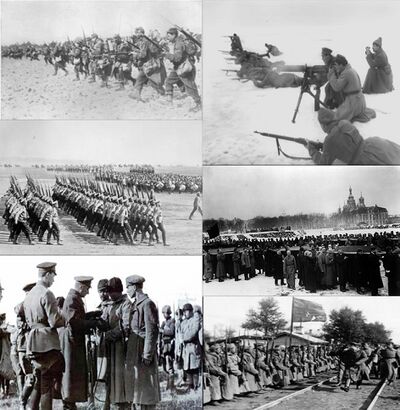Khozhlodi Civil War
| Khozhlodi Civil War | ||||||
|---|---|---|---|---|---|---|
 Clockwise from Top left; White forces defending from an incoming red forces along the Liv-Laskhin Railway, Early stages of the building of the Morograd Line, Fieldmarshal Vassily Taburitsky greeting red soldiers before being sent to fight in the Swamp Campaign, Supereme leader Alexi Sablin rewarding soldiers during the 1914 Winter Railway Offensive, Red soldiers marching to lay siege to the Morograd Line, Soldiers of the Republic of Yikrunia attacking a red formation in mid-1915. | ||||||
| ||||||
| Belligerents | ||||||
|
|
|
| ||||
| Strength | ||||||
| 3,100,000 Soldiers | 6,000,000 Soldiers | 2,000,000 Soldiers | ||||
| Casualties and losses | ||||||
|
1,110,000 Dead 1,550,000 Wounded |
3,000,000 Dead 1,500,000 Wounded |
1,500,000 Dead 300,000 Wounded | ||||
| Civilians: 3,000,000 Dead, Unknown Wounded | ||||||
The Khozhlodi Civil War (Khozhlodian: Гражданская война в Хожлоди; Romanized: Grazhdanskaya voyna v Khozhlodi) was a multi-party civil war in the former Tsardom of Khozhlod that was sparked by the overthrowing of the Tsar, and the inability of the Republic, to maintain stability across the country, which resluted in the formation of the Khozhlodi Revolitionalry Republic and the Khozhlodi State, along with the breakaway of several statelets,it's finale marked the end of the failed Khozhlodi Revlolution.
Theaters of the war
North
Yikrunia
Following the collapce of the central government, the Republic of Yikrunia has declared it's indepandence on 27 November 1912 the following day, the Khozhlodi Revolitionalry Republic declared war on the Republic of Yikrania.
after several battles, the Republic of Yikrania capitulated with the end of the Siege of Kjav, annexing the land to the Khozhlodi Revolitionalry Republic
Tundra
Leading to the collapce of central authority, skirmishes between Communist and Nationalist militias along the Liv-Laskhin Railway became more and moore fearquent, which resulted in the formation of the Sumpere Authority of Khozhlod to counter the Khozhlodi Revolitionalry Republic.

At first the Sumpere Authority of Khozhlod had the upper hand, due to the 2 front war waged by the Khozhlodi Revolitionalry Republic, and getting as close to 100 kilometers from Khozhograd in mid-1915, but with the end of the Yikurnian Uprising, the Khozhlodi Revolitionalry Republic sent forces quick enough to blunt the 1915 Winter Offensive, and push back the Sumpere Authority of Khozhlod, The Tundra Campaign would wage on for 2 more years until the capitulation of the Sumpere Authority of Khozhlod in late-1917.
This front will only see combat again in early-1920 with the Laskhin Landing, a naval landing operation conducted by the Khozhlodi Reactionary Government, resulting the the capturing of the city, and as the bulk of revolutionary forces were stuck in the mountains and the plains beyond, they would face little resistance on their way to Khozograd, and on 10 December 1920, they entered the city and fought the remaining revolutionary forces that remained there, it would take them six more days to claim victory over the capital and end the war.
Midlands
Mountains
The Khozhograd-Laskh mountain range was an area of vast stratigical importance to control, as it could be used to shell enemy positions on the lower plains, which is why both the Revolutionary Council of Khozhlod and Khozhlodi State struggled for control over it, as large army formations couldn't fight in such terrain, the fighting was mainly done by small infantry dertachments and even combat aircraft, slowly and bit by bit, the forces of the revolutionary council advanced and claimed mountain by mountain, and from there, it took just a few more months to overwhelem the Khozhlodi State in the plains all the way to the Morograd Line.
Plains

While small detachments of intantry fought over the mountains, the larger scale war was fought over the plains of the Khozhlodi Midlands, with vast networks of trenches and forts being dug and constucted in haste and assualteed in the same spirit, but with very little change of ground due to counteroffensives, with the capturing of the mountains by the Revolutionary Council of Khozhlod in late-1916, the Grand Spring Offensive was set in motion, and the Khozhlodi State was pushed back to the Morograd Line before a halt in the offensive due to both streched supply lines, and the unification of the Revolutionary Council of Khozhlod with the Khozhlodi Revolutionary Republic.
seizing the oppurtuinty in the halt, The marshal Baron Vladimir Storkovich staged a successful coup in Sevastok and proclaimed the Khozhlodi Reactionary Government, and began to plan for the end of the war by landing troops in Laskhin and holding out in the plains until they would capture the capital and capitulate the Revolutionary Republic, in mid-1918 the attacks renewed in what became to be known as the Morograd Defense, the Morograd defense would last two years until mid-1920 when it will transform into the Morograd Counteroffensive after hearing of the success of the Laskhin Landing with the objective to keep the revolutionary forces busy to allow the troops in Laskhin to make it to Khozograd.